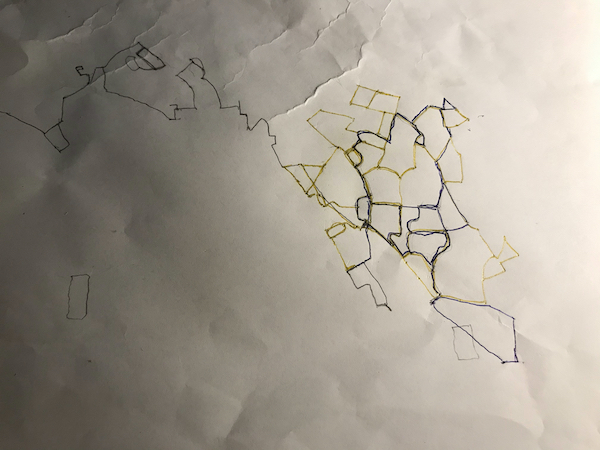Yesterday my daughter and I left the house and flipped a coin. Heads for left, tails for right. Right it was, then left, then left again, et cetera. A random journey along the roads, cyclepaths and alleyways of our neighbourhood ensued. It became a fun home-schooling lesson in probability. It revealed to me the habits that stop me from noticing so much of what surrounds me. And it was a fascinating experiment in not having a plan.
These days, leaving the house on an overcast day can be a challenge. Usually there has to be promise of some sort of an exciting destination (after all, going to meet someone is not on the cards). But what if not knowing where we were going became the excitement. I said, ‘let’s play the Left-Right game’, and it was enough motivation to get shoes and us out of the door.
As we went we both noticed ourselves hoping that chance would take us to a certain park, or along a particular road. We noticed having to give up on certain desires when fortune dashed our hopes; but then new possibilities would emerge.
Crossroads presented an early challenge. There are three possibilities but only two sides to the coin. We gave ourselves a new rule. At a crossroads, flip once – heads for head on; tails to turn. If that latter, heads for left, tails for right, as before. It got us out of an impasse, but in my head I’m starting to run through the consequences for the trace of our random path of this new decision rule. The crossroads rule prioritises going straight on. This was me starting to impose some control of the situation. I wanted us to make some progress, get some speed up. Once we were going I wanted to carry on.
With hindsight I feel this is a sort of future-centred mindset, rather than a present-centred mindset. Being motivated by where I will be rather than where I am. For me it’s a microcosm of the lockdown experience. Everything that I was looking forward to from the end of February has been cancelled. I have had to find new excitement and contentment in the near and present. It has forced me to be more aware of what motivates me and what I am thinking about.
Back on our random journey, we loop around a block of local residential streets that I have never seen before. Had I been nine, hanging out on my BMX, these would be streets I would have known from just pedalling around the neighbourhood to see what’s there. But as an adult I need a maths game to find out what’s around me!
Finally we drop onto the nearby national cycle route four, a long distance path that is hopefully going to take us further afield. I start to think about what might be the impact on our trace of different navigational rules. What if we changed the probabilistic rules to prioritise going forward and right in a spiral? What rules would make it a logarithmic our a hyperbolic sprial? And how are these a function of the streetscape too?
Alas my image of future self zooming out of town along the cycle path was punctured by a left turn into Morrison’s, but were soon away again down a little alleyway and into parts of the neighbourhood that I had never seen before.
Finally, poised to take a turn into unknown realms, it was time to go home. We took a photo of our last location and the result of the final coin toss, ready to take up the journey with chance again. We were both really disappointed to end there. I had this feeling of being really alert and engaged in surroundings I had previously written off as not interesting. I also felt really together with my travelling partner. We had taken this journey into the local unknown together; shared our hopes, seen them dashed, and discovered new places with each other. It was a really revitalising experience.
Back at the house, I couldn’t stop myself from wondering where we might have ended up. We pinned a map on the wall, and began to trace our on-going journey over it, flipping the coin to work out which way we would have turned. As it turns out, thirty more flips of the coin would have seen us heading out of town on the Old Gloucester Road.
We began another journey, this time all virtual on the map, with the same directional rules. From the same starting point we ended up going round the neighbourhood in repeating loops, seemingly stuck in some intractable probalistic orbit of an industrial estate, unable to achieve some sort of escape velocity. We tried a different rule: rather than using proability, what about just going left, left right. This time we managed to escape the local circuit in a different direction.
Fascinating as it was from a mathematical perspective, this virtual journey didn’t make me feel good. Actually it almost made me feel a bit queasy – like travelling without moving. Without being coupled to physical movement and sensory input the virtual journey lacked meaning and was actually disorientating. And without any physical embodiment of the small-scale jeopardy of not-knowing, the experience lost all vitality.
I’ve learnt from clown training the concept of being ‘put in the shit’ – deliberately looking for situations in which we lose control. It is fascinating, and entertaining, to watch someone else lose control – we are drawn in to watching what ensues. And for the clown it can be exhilirating to let go of control and see what happens. It’s an experience that roots you firmly in the present.


Leave a Reply